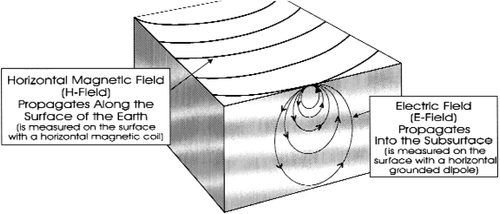Magnetotellurics survey measurements
What is measured?[edit]
Two basic alternating current (AC) measurements are taken in an MT survey: a horizontal magnetic field (H-field) measurement and an electrical field (E-field) measurement. The E-field is always measured perpendicular to the H-field data.
The H-field[edit]
The H-field is the “source” signal, or the primary field. It propagates across the surface of the earth. Because it does not travel in the subsurface, the H-field data do not provide information about the subsurface geology.
Very limited information about the subsurface geology can be interpreted from the vertical H-field if this component is measured. The vertical H-field is called the tipper.
The horizontal H-field is measured with a horizontally oriented magnetic coil. The tipper is measured with a vertically oriented coil.
Be careful not to confuse an MT survey with a magnetic survey. An MT survey does not measure the magnetic properties of the subsurface rocks, as does a magnetic survey.
The E-field[edit]
The E-field is the secondary field, generated by the H-field propagating across the surface. Each time the primary H-field (an AC signal) switches polarity, a secondary E-field (current flow) is generated in the subsurface. Thus, the horizontal E-field data provides information about the subsurface geology.
This is the same physical principle as the alternator in a car. An alternating or spinning magnetic field (H-field) sets up current flow in the wire windings in the alternator, which in turn charges the battery. In the case of an MT survey, the “wire” is the earth.
The E-field is measured with a grounded dipole typically 50–200 m long. All subsurface geology information is contained in the E-field data. However, without the H-field data, we cannot calculate resistivity.
Figure 1 shows the relationship between the E- and H-fields.
Resistivity calculation[edit]
The resistivity calculation is a simple ratio of the primary source signal (H-field) and the secondary current flow in the earth (E-field), with a modifier for the frequency at which the data were acquired:
where:
- E = magnitude of the E-field
- H = magnitude of the H-field
- f = frequency
See also[edit]
- Magnetotellurics
- Magnetotelluric data acquisition
- Magnetotellurics case history: frontier basin analysis (Amazon Basin, Colombia)
- Magnetotellurics case history: rugged carbonate terrain (Highlands of Papua New Guinea)
- Magnetotellurics case history: Precambrian overthrust (Northwestern Colorado)
- Magnetotellurics case history: volcanic terrain (Columbia River Plateau)

